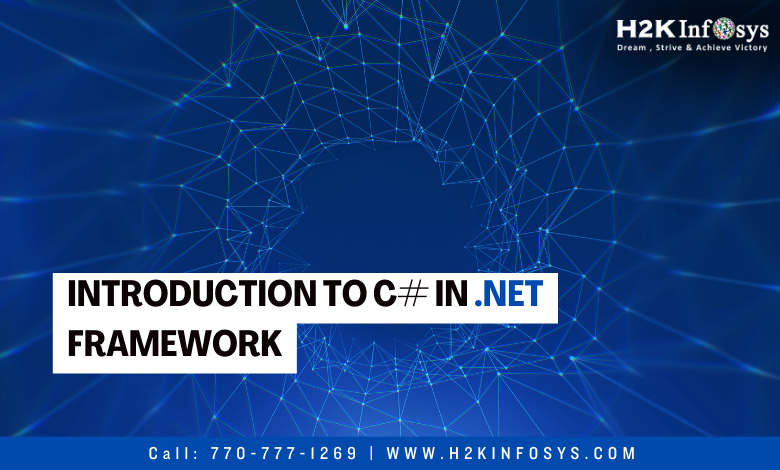Microsoft developed C#, also referred to as C Sharp, in 2000. The .NET Framework uses the object-oriented programming language C#. A vast array of desktop, online, and mobile applications are frequently created using C#, which is intended to be easy to use, effective, and adaptable.
A runtime environment, as well as a collection of libraries and tools, are provided by the .NET Framework, a software development framework, for creating and executing Windows programs. The framework supports a wide range of application types, including desktop, web, mobile, and gaming apps, and comes with a number of programming languages, including C#. Check out the online .NET training to learn more.
Two fundamental components make up the architecture of the.NET Framework:
- Common Language Runtime (CLR): Code written in any language supported by .NET must be managed during execution by the Common Language Runtime. Upon launching an application, the CLR instals the necessary libraries and translates the code into machine code that the computer’s processor can execute. In addition, the CLR offers several features that contribute to the dependability and security of applications, including autonomous memory management and security.
- .NET Framework Class Library (FCL): A vast array of pre-built classes and functions are available in the .NET Framework Class Library, which may be utilised to develop a variety of applications. Numerous namespaces in the library give users access to classes that offer functions including file input/output, networking, database access, and graphical user interface (GUI) design. A variety of development tools are also included in the library. One such tool is the Visual Studio integrated development environment (IDE), which offers an extensive toolkit for creating and debugging.NET applications.
The.NET Framework consists of several components, including the Common Type System (CTS), the Common Intermediate Language (CIL), and the Just-In-Time (JIT) compiler, in addition to the CLR and the.NET Framework Class Library. Together, these parts provide a strong and adaptable development platform that can be utilised to create a variety of applications.
All things considered, C# and the .NET Framework offers a strong and adaptable programming environment that is frequently utilised for creating desktop, online, and Windows operating systems.
Microsoft is the company that created and developed the .NET software framework. The .Net framework was initially released in 2002 with version 1.0. Put simply, it’s a virtual computer that can be used to compile and run programs written in various languages, such as VB.Net and C#. Web services, Web-based apps, and Form-based applications are developed using it. The .Net platform supports several different programming languages; the most popular ones are C# and VB.Net. Applications for Windows, phones, the web, etc. are developed with it. In addition to offering many features, it complies with industry requirements.
Basic Architecture and Component Stack of .NET Framework
The .Net framework’s fundamental architecture, which debuted in 2005, is represented by the first three components from the bottom. Microsoft later added additional components to the.Net Framework in the manner described below:
- CLR (Common Language Runtime): Code written in any.NET programming language can be executed by the CLR (Common Language Runtime) run-time environment. Numerous languages, including C#, F#, C++, Cobra, Jscript.Net, VB.Net, Oxygene, etc., are supported by the Net Framework.
- FCL (Framework Class Library): This framework, also referred to as FCL, has a huge number of class libraries.
- Types of Applications: Primarily the built-in applications.The three categories of net framework are as follows:
- WinForms: Applications that use forms are included in this category. To put it simply, this category includes client-based apps that can both read and write to the file system.
- ASP.NET: This group includes web-based programs. Web applications, websites, and web services can be developed with the help of the ASP.Net framework, which offers a fantastic integration of HTML, CSS, and JavaScript. Web services are now a feature of ASP.NET web applications and were introduced with the release of the.Net Framework 2.0.
- ADO.NET: This refers to the programs created to interface with databases, such as Oracle, MS SQL Server, and so on. Classes that are useful for connecting, retrieving, inserting, and deleting data make up the majority of it.
- WPF (Windows Presentation Foundation): Microsoft provides Windows Presentation Foundation (WPF), a graphical subsystem that renders user interfaces (UI) in Windows-based applications by utilising DirectX. WPF, formerly known as “Avalon,” was first made available in 2006 as a component of the.NET Framework 3.0.
- Windows Communication Foundation (WCF): This is a platform for creating service-oriented, networked applications that transfer data asynchronously between service endpoints. It was formerly called the Indigo.
- Windows Workflow Foundation (WF): This Microsoft technology offers a framework for creating processes inside .Net applications.
- Card Space: This software client for the Microsoft .NET Framework was created to enable users to authenticate themselves digitally to internet services in a secure, simple, and trusted way.
- LINQ (Language Integrated Query): Version 3.5 of the.Net framework introduces it. In essence, it is a query language that may be used with the C# or VB programming languages to query data sources.
- Entity Framework: It is an open-source framework built on top of ORM (Object Relational Mapping) .Net Framework version 3.5. It makes it possible for.Net developers to use.Net objects to interact with databases. The entity framework came first. Database-related tasks were undertaken by net developers in large quantities. Developers must construct a Data Set in order to get or submit data to the database, convert data from the Data Set to .NET objects, or both. This process is similar to opening a connection to the database. Developers find it challenging, and the process is prone to errors. Fortunately, “Entity Framework” steps in to automate all of these database-related tasks for the application. Thus, developers can work at a greater level of abstraction thanks to Entity Framework
Note: In order to improve the web services provided by the .NET Framework, REST (Representational State Transfer) and AJAX were included as ASP.NET extensions and services in version 3.5.
- Language Integrated Query (LINQ) in parallel: It is also known as PLINQ and is included in the.Net Framework version 4.0. It offers a LINQ concurrent query execution engine. In order to make the most use of the computing power available on the system, it runs the LINQ in parallel.
- The Task Parallel Library, or TPL for short, is a collection of public types and APIs. It makes the process of adding concurrency and parallelism to .Net applications simpler, which enables developers to work more productively.
- .NET API For Store/UWP Apps: Microsoft provided a few APIs in 2012 that let developers use C# or VB to create Windows programs for the Universal Windows Platform.
- Task-Based Asynchronous Model: This model explains how the.Net Framework’s asynchronous tasks and operations work.
Conclusion To learn more about .NET, check out the online .NET course.
























